Summer Gardener’s Calendar
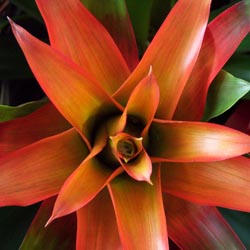
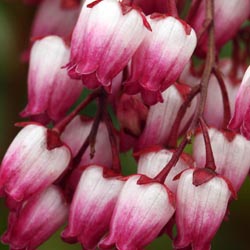
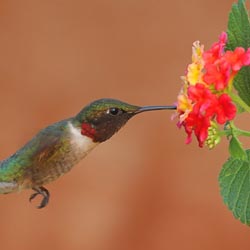 Continue planting trees, shrubs, perennials, annuals, vegetables and herbs. Consider adding some exotic color to your deck or patio with tropical blooming plants. We have a great selection of color this summer.
Continue planting trees, shrubs, perennials, annuals, vegetables and herbs. Consider adding some exotic color to your deck or patio with tropical blooming plants. We have a great selection of color this summer.
It’s time for your houseplant’s summer vacation! Take outside to a shady place. Repot if necessary, fertilize and check for pests and diseases. They’ll thrive in their outdoor location all summer. Be sure to bring them back inside in early fall.
Water plants and lawns deeply during periods of dry weather. Annuals, perennials, vegetables, trees and shrubs should be watered with a slow trickling or soaker hose. Pay extra attention to plants in containers and hanging baskets – check them regularly. Remember that clay pots dry out faster than plastic.
Apply a 2-3″ layer of mulch on your garden beds in preparation for summer. Mulch conserves valuable moisture in the soil, helps keep weeds down, maintains even soil temperatures, and gives an attractive finishing touch to your beds and borders.
Spray azaleas, Pieris japonica, laurel and Rhododendron with Bonide All-Season Oil to control lacebug. Spray early in the morning or evening when temperatures are moderate and there is no rain in the forecast.
Warm, humid weather encourages the development of fungal diseases such as Black Spot and Powdery Mildew on roses. Water roses in the early morning and avoid overhead watering if possible. Clean up any fallen leaves and follow a regular fungicide spray program. We recommend the Bayer Rose and Flower All in One for good control of fungus diseases.
Prune evergreens such as pines, cypress, hollies, euonymus and boxwood, to shape as needed. Remove faded flowers of annuals regularly, to encourage more flowers. Annuals will also benefit from regular applications of a water-soluble fertilizer right through summer.
Attract hummingbirds and butterflies to your landscape by planting Butterfly Bush, Bee Balm (Mondarda), Hardy Hibiscus, Lobelia, Scabiosa and Coreopsis.
Grow Your Own Grilling Herbs
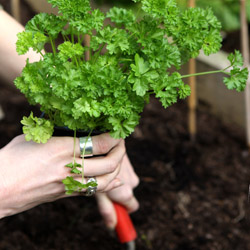

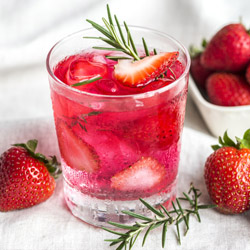
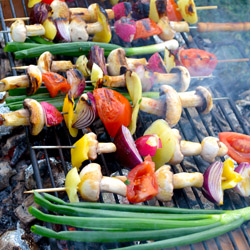 There’s nothing that tastes more like summer than anything grilled – from a prime cut steak to a juicy chicken breast to all your favorite burgers, bratwurst, and garden veggies. But to bring out the fullest flavor of a grilled menu, you need the very best herbs. Why not grow your own herbs for the richest, freshest flavors right from your garden?
There’s nothing that tastes more like summer than anything grilled – from a prime cut steak to a juicy chicken breast to all your favorite burgers, bratwurst, and garden veggies. But to bring out the fullest flavor of a grilled menu, you need the very best herbs. Why not grow your own herbs for the richest, freshest flavors right from your garden?
Flavoring with Herbs
Smoking is the most common and familiar flavoring technique for grilling, using different types of wood with subtle notes of maple, hickory, and apple to enhance meat and vegetables. Grilling with herbs can be even tastier and infuses grilled food with rich flavors and earthy freshness. This can also be a very healthy option for seasoning food, as there is no need for heavy sauces filled with salt and preservatives. Different combinations of herbs can also add many different flavor notes to beef, chicken, and fish, as well as creating more flavor depth for all types of vegetables.
Why Grow Your Own Herbs?
Herbs are at their most flavorful with the most seasoning power as soon as they are picked. The oils and flavonoids that add aroma and taste to herbs begin to evaporate and fade as soon as a sprig is snipped, and if you purchase herbs you have no way to know how long ago they were picked before they arrived at a store or farmer’s market and made it to your grill. If you grow your own grilling herbs in containers or right in your garden, however, you can snip, pick, pluck, and chop the herbs just seconds before they’re added to your grill, ensuring the most robust flavor and biggest impact on every dish you grill.
Best Herbs for Grilling
All different herbs can be used while grilling, though hardier plants with stronger flavors are typically preferred because they will stand up to the heat of the grill more easily, giving foods the best infusion of flavor. Popular herbs that are versatile for all types of grilling include:
- Chives
- Dill
- Mint
- Oregano
- Parsley
- Rosemary
- Tarragon
- Thyme
Choose different varieties of these great grilling herbs or your other favorite herbs to experiment with different subtle flavors, and combine herbs in different ways for amazing flavor profiles.
Grilling with Your Herbs
There are two different ways to grill with fresh herbs. Finely chopped fresh herbs can be sprinkled directly onto coals that have ashed over, and will add subtle aromatic flavors to any food being grilled. For stronger, more direct flavoring or for use in a gas grill without coals, use whole sprigs of herbs to create a mat or bed on the grill’s grate. Place the meat or vegetables directly on the herbs, similar to plank grilling, for direct infusion. To help release the herb flavors even more, soak the sprigs briefly before adding them to the grill for either cooking method.
Indirect heat is best for grilling with herbs, as it will give the meat more time to absorb the subtle flavors of the herbs, and the herbs will not burn or char, which could taint their flavor. Close the lid and allow the herbs to work their magic, and you’ll be rewarded with grilled meats and vegetables that are more amazingly seasoned and flavorful than you could have imagined.
More Flavorful Summer Foods with Herbs
Grilling with herbs can make meat the centerpiece of your summer dining experience, but there are many other ways to use your garden-fresh herbs in tasty dishes to accompany a grilled extravaganza. Add herbs to…
- Marinades to give meats even more flavoring before they’re grilled.
- Salads for more flavor notes that pair well with vegetables from your garden.
- Drinks for a unique flavor profile in summer teas and lemonades.
With so many uses for grilling herbs – both on the grill and off – you’ll want to be sure to add plenty of these flavorful plants to your garden for a full menu of delicious summer options.
Spring Flowering Fantasy
The arrival of spring is evident more in the blossoms of trees than anything else. The joyful coloring of the landscape by spring-flowering trees truly lifts the spirits – the pinks and whites of dogwoods and crabapples, the glorious blossoms of magnolia and ornamental pears that magically appear almost overnight. Together, they proclaim that winter is finally over.
Some of our favorite early flowering trees include:
Magnolia – The first to bloom is the Star Magnolia with its many petaled, white flowers. A week later several varieties of Saucer Magnolias make their debut with big, rich, full, cup-shaped flowers in shades of white, pink and purple.
Ornamental Pear – Smothered with small white flowers, Ornamental Pears also have rich leaf color in late fall. Use as a specimen or accent as well as a street tree.
Ornamental Cherry – Every landscape should have at least one cherry tree. The breath-taking Weeping Cherry announces spring’s arrival, followed by the famous Yoshino Cherry of Washington D.C. Next, the popular vase-shaped Kwansan Cherry explodes into bloom with deep pink, double flowers.
Redbud – An adaptable tree with charming bright purple flowers along its bare branches. ‘Forest Pansy’ also boasts purplish foliage all summer. This is one of the few trees that will tolerate shade.
Dogwood – Our native Dogwood is one of the most beautiful flowering trees. Graceful flowers in white, pink and red appear to float on its bare branches. In fall, leaves turn to a reddish purple color with clusters of red berries.
Seed Starting
Starting seeds indoors is a rewarding gardening experience and can help extend your growing season to include more plant varieties than your outdoor season may permit. Furthermore, a larger selection of seed varieties doesn’t limit your opportunities to growing only those transplants that are available at planting time. The key to success in growing seedlings is in creating the proper environment.
What Seeds Need
Seeds are generally hardy, but to start them properly they do need gentle nurturing so they can produce healthy, vibrant plants. In general, seeds should be started 4-6 weeks before the recommended planting time so the seedlings will be large and strong enough to withstand the stresses of transplanting. Use a sterile growing mix which is light enough to encourage rich root growth. Sow the seeds thinly and cover lightly with sphagnum peat moss. Water using a fine spray but do not soak the seeds – they also need oxygen to germinate, and if they are overwatered they will drown. Cover the container with clear plastic to hold the moisture and increase humidity. Place the containers in a warm (70-80 degrees) spot and watch daily for germination. The top of the refrigerator is often an ideal location. When the first seeds germinate, place the seedlings in bright light or under artificial lights (tube lights should be 2-3” from seedling tops) for several hours each day, since late winter sunlight will not usually be sufficient to prevent weak, leggy seedlings. Daytime temperatures should range from 70-75 degrees. Night time temperatures should range from 60-65 degrees.
As Seeds Grow
When the seedlings develop their first true sets of leaves, add half-strength water soluble fertilizer to their water – organic fish emulsion or seaweed fertilizers are great to use. Repeat every second week to provide good nourishment. Thin the seedlings or transplant them to larger containers as they grow. Before planting outdoors, harden-off the plants at least one week before the planting date. Take the transplants outdoors in the daytime and bring them in at night if frost is likely. Gradually expose them to lower temperatures and more sunlight. The use of hotcaps and frost blankets to cover early plantings will also aid in the hardening off process so the seedlings can adjust well to their new outdoor environment.
Transplanting Seeds
Transplant seedlings into the garden after the safe planting date on a calm, overcast day. Pack the soil around the transplant with as little root disturbance as possible. Sprinkle the plants with water, keeping the soil moist until the plants become established.
Popular Indoor Seed Start Dates
The exact dates you want to start seeds will vary depending on your local growing season, the varieties of plants you choose and what their needs are. In general, dates for the most popular produce include…
Vegetable Seed Starting Dates
- February – Asparagus, celery, onion
- March 1 – Broccoli, Brussels sprouts, cabbage, cauliflower, collards, kale, lettuce
- March 15 – Eggplant, peppers, tomatoes
- April 1 – Summer squash
- April 15 – Cantaloupes, cucumbers, winter squash
Flower Seed Starting Dates
- January/February – Begonia, carnation, geranium, impatiens, nicotiana, pansy, rudbeckia, salvia, snapdragon, verbena, vinca
- March 1 – Ageratum, dahlia, dianthus, petunia
- April 15 – Aster, calendula, celosia, marigold, zinnia
Use seed starting dates as a general guide to ensure your seeds have plenty of time to reach their full harvest potential before the weather turns in autumn. At the same time, consider staggering seed starting every few days to lengthen your harvest and keep your favorite vegetables and flowers coming even longer during the growing season. As you gain more experience with starting seeds, you’ll be able to carefully plan your seed calendar to ensure a lush, rich, long harvest season.
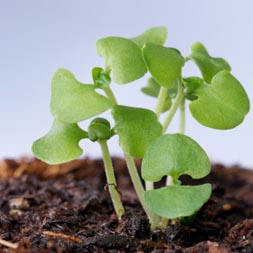
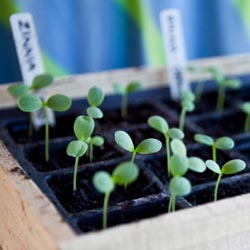
Early Spring Gardening Calendar

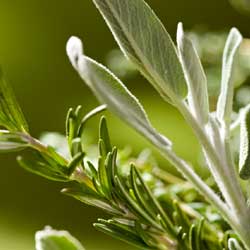
 * Plan your summer vegetable and herb garden. We offer a wide selection of seeds that include all of your favorite annuals, perennials, vegetables and other novelties as well as many hard-to-find selections. Inventory your pots and flats and discard unusable ones. Make a list of the supplies you will need. Have your garden soil tested for nutrient content. We offer a variety of do-it-yourself soil test kits.
* Plan your summer vegetable and herb garden. We offer a wide selection of seeds that include all of your favorite annuals, perennials, vegetables and other novelties as well as many hard-to-find selections. Inventory your pots and flats and discard unusable ones. Make a list of the supplies you will need. Have your garden soil tested for nutrient content. We offer a variety of do-it-yourself soil test kits.
- Prune woody plants while dormant, including fruit trees, summer- and fall-blooming shrubs and vines. Limit pruning of spring-blooming trees and shrubs to the removal of sucker growth and rubbing or broken branches. Spray trees and shrubs with year-round horticultural oil to reduce insect population.
- Sharpen, clean and oil tools and lawn mowers. Begin heavy annual pruning of shrub roses as new leaves appear.
- Plant pansies, English daisies and primrose as soon as the earth is workable. Plant strawberry plants. Sow cool-season vegetables and herbs in the garden.
- Start spring cleanup and begin major lawn work. Remove debris, dethatch your lawn or aerate compacted areas to improve water penetration.
- Spray needles and limbs of Arborvitae, Cryptomeria, false cypress, fir, hemlock, Juniper, pine, yew and spruce (except blue spruce) for spider mites with year-round horticultural oil.
- Apply fertilizer to perennials and roses with. Feed berry bushes, grapevines, rhubarb and asparagus a balanced 10-10-10 fertilizer before new growth begins. Fertilize trees and shrubs.
- Apply crabgrass preventer with fertilizer to feed the lawn and control crabgrass. Do not use on newly seeded lawns.
- Continue spring cleanup. Cultivate to remove winter weeds and debris from the planting beds. Apply corn gluten or a pre-emergent herbicide with fertilizer specified for gardens and scratch it in to prevent future weeds. Do not use in gardens where you will be direct seeding.
- Reseed bare spots in established lawns. Keep the area moist until seedlings appear, then mow when the new grass is 3″ high.
- Prune forsythia and other spring-flowering trees & shrubs after the flowers fall.
Fall Chrysanthemums
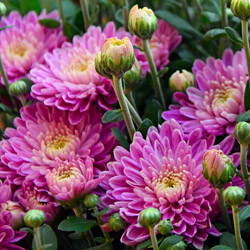
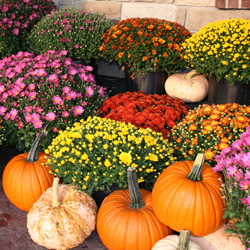


 No flower is more iconic of autumn than the chrysanthemum, and these beautiful mounding perennials are ideal for fall flowerbeds, pots, window boxes, borders, and many other uses. How will
No flower is more iconic of autumn than the chrysanthemum, and these beautiful mounding perennials are ideal for fall flowerbeds, pots, window boxes, borders, and many other uses. How will
you get creative with chrysanthemums this fall?
Why We Love Chrysanthemums
Just when many other flowers are fading at the end of summer, chrysanthemums, or mums, are coming into their glory with a range of stunning autumn colors. Depending on the cultivar, these plants sport yellow, white, red, orange, bronze, pink, peach, wine, purple, and bicolored blooms. The flowers range from small, button-like blossoms to larger blooms reminiscent of daisies. Mum blooms are long-lasting when cut and they’re just as lovely in floral arrangements and bouquets as they are planted in containers, flowerbeds, and the landscape. This makes mums extremely useful for all manner of autumn décor.
Chrysanthemums are native to east Asia and northern Europe and were first domestically cultivated in China nearly 600 years ago. Today, there are more than 20,000 chrysanthemum cultivars worldwide. They are deer- and rabbit-resistant, making them a hardy option for landscaping beds, and with a bit of thoughtful care, these tender perennials can be a wonderful addition to any flower garden or fall containers.
Caring for Chrysanthemums
The hardiness of chrysanthemums depends on the cultivar as well as the local climate and even the microclimate in your landscape. These flowers prefer well-drained, rich soil with a neutral pH, so it is best to use a good quality potting soil in containers. When planting chrysanthemums in the garden or landscape, mixing compost or peat moss in the planting hole will help increase drainage and nourish the soil to promote the best blooms. A good rule of thumb is that if soil is good for vegetables, it will also be good for mums – making them a wonderful choice to refresh a garden after the summer harvest has finished.
Chrysanthemums grow best in full sun requiring a minimum of six hours per day. If mums are planted in containers, consider using a mobile plant cart or a stand with casters so that the pots may be moved to brighter areas, if needed, as the season progresses.
Chrysanthemums prefer evenly moist, but not soggy, soil. Because of their thick, mounding habit, it is best to water mums from below suing a soaker hose or irrigation drip system in garden beds. In pots, mums should again be watered from below the plant but above the soil line. A watering wand will make this job direct and easy. Be sure to drain excess water from saucers after watering so the roots do not remain continually wet.
Fertilizing chrysanthemums every month through the spring and early summer, with a balanced fertilizer, will help them grow and bloom well, but if mums are planted in the Fall, they should not need extra feeding as long as they were planted in rich, nutritious soil. Deadheading spent blooms by pinching them back can encourage more flowering and help mums maintain their compact, mounding habit.
Decorating with Fall Mums
Chrysanthemums are a beautiful choice not only in the garden, but are equally lovely in welcoming porch pots, deck or patio containers, or even small indoor pots and arrangements. Add an extra touch of fall with rustic containers, such as wine barrels, baskets, or terra cotta pots, or glam up your mums in hammered copper or bronze pots that will accentuate their color. A burlap ribbon or bow can be a charming accent, and you can give more seasonal flair to mum arrangements or flowerbeds by adding pumpkins and gourds as fun decorations. Indoors, use small pails or pots for petit mum arrangements, or add them to larger arrangements with grain sprigs, dried pods, colorful leaves, or twists of grapevine for additional texture.
Fall chrysanthemums can be a pleasant burst of autumn color, whether they are part of the landscape or are used in containers, pots, or arrangements and we carry a wide selection to make your fall home suit the season!
Plant a Tree This Fall

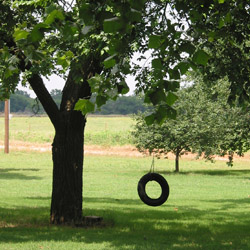 There are so many reasons to add a new tree to your landscape this fall that it’s hard to find a reason not to.
There are so many reasons to add a new tree to your landscape this fall that it’s hard to find a reason not to.
Just think about it, trees will…
- Beautify the Environment
Trees add texture and color to the landscape. They soften the harsh lines of buildings and driveways, while their foliage and blooms add seasonal color changes and variety.
- Stabilize Soil
Tree roots prevent soil from blowing or washing away, minimizing erosion and providing protection for the surrounding landscape.
- Provide Wildlife Habitat
Trees provide shelter and food for birds and numerous small animals, including squirrels, raccoons, insects and more.
- Make Food
Many trees provide fruits, nuts, seeds, sap and berries for human consumption. Wildlife will also rely on the food provided by trees.
- Create Oxygen
Through photosynthesis, trees take in carbon dioxide, carbon monoxide, sulfur dioxide and other poisons from our air and release pure oxygen for us to breathe. One tree can produce enough oxygen for 10 humans for one year!
- Filter the Air
Trees act as giant filters trapping dust and pollution particles with their leaves and bark until the rain washes the particles away.
- Cool the Air
Air will remain several degrees cooler in the shade of a tree canopy. This is accomplished by not only by blocking the sun’s rays but also through transpiration. Tree leave transpire, or release moisture, which cools the surrounding air. A large tree can release as much as 400 gallons of moisture from its leaves daily.
- Reduce Utility Bills
Deciduous trees planted on the south and southwest sides of a home will shade the structure during hot summer months and reduce air conditioning or other cooling needs. In the winter, with the leaves fallen, the sun is able to warm the structure, reducing heating bills.
- Reduce Noise Pollution
Strategically planted, trees can dramatically reduce the volume of unwanted noise from loud neighbors, nearby businesses or car traffic.
- Hide undesirable views
Purposefully sited, trees can camouflage unattractive views and create privacy, providing a natural sanctuary in your yard.
In our area, fall is just about the best time of year to purchase and plant a tree. The soil is warm, air temperature is cool and morning and evening dew increase available moisture to nurture a new tree. Stop in and see our extensive collection, and we can assist you in choosing the tree that is perfect for your landscape and lifestyle needs.
Autumn: Why Plant Now?
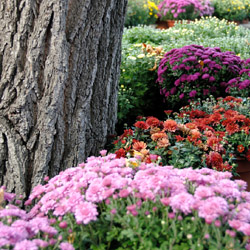 Although many gardeners plant trees and shrubs in the spring, knowledgeable gardeners plant in the fall to take advantage of all this fabulous season has to offer. But why is fall planting better than spring planting?
Although many gardeners plant trees and shrubs in the spring, knowledgeable gardeners plant in the fall to take advantage of all this fabulous season has to offer. But why is fall planting better than spring planting?
- Stress Reduction
Transplanting causes stress as plants are removed from containers, balls or established locations and changed to new locations. Planting in the fall, when a plant is entering dormancy and is generally hardier and sturdier, reduces this stress so the plant can thrive.
- Establishing Strong Roots
Fall planting “establishes” trees and shrubs by encouraging root growth. Because the soil is still warm, the roots continue to develop until freezing, though the upper parts of the plant are already dormant. When transplanting in the spring, the developed roots are active and delicate tips or rootlets, as well as buds and new leaves, are more easily damaged.
- Weather Resiliency
Trees and shrubs planted in the fall are better able to withstand the rigors of the next summer’s heat and dry conditions because they have much longer to develop healthy roots systems and become thoroughly established. This is especially critical in dry climates or areas prone to drought or irregular rainfall.
- Faster Maturity
The “head-start” of fall planting results in a larger plant in less time, helping create a mature landscape without waiting for smaller plants to catch up. This can be especially critical when replacing dead or damaged plants in a mature landscape to avoid a gap or uneven look.
- Water Conservation
Planting in the fall saves watering time and promotes conservation by eliminating daily watering. Cooler temperatures with the addition of both morning and evening dew contribute greatly to soil moisture availability in fall without as much supplemental watering.
- Color Confirmation
Fall is the best time to see a plant’s autumnal color. Planting in the fall eliminates the surprise of the wrong color or unexpected shades that may not coordinate with nearby plants. By planting in autumn, you’ll know exactly what you’re purchasing and planting, and you will be able to match better with your existing landscape.
- Saving Money
Last but definitely not least, buying your beautiful trees and shrubs in autumn can save big money. We discount prices on trees and shrubs to create room for holiday season materials and pass the savings on to you. Selection may be more limited later in fall, however, so don’t wait too long to take advantage of great savings.
Autumn can be the ideal time to plant trees and shrubs, whether you are adding to your landscape, replacing plants or starting a whole new look. If you plant in autumn, you’ll be amazed at how lovely your landscape will look next spring.
Fall Gardener’s Calendar
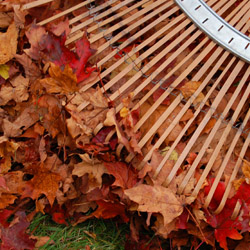
 SEPTEMBER
SEPTEMBER
Spray Bonide All-Season Spray on hemlocks to control woolly adelgid.
Spruce up the landscape by planting Fall Pansies, Flowering Cabbage & Kale, Garden Mums, Fall-Blooming Perennials as well as Trees and Shrubs.
Test your lawn pH to determine if you need to apply lime this season. A 5o lb. bag of Lime will raise the pH about a half a point per 1000 square feet of turf.
Pick up your Spring Flowering Bulbs like tulips, daffodils, crocus, hyacinths, snowdrops and more! An Auger for the drill will also help make planting easier.
Plant cool-season salad greens (arugula, corn salad, lettuce, radishes and spinach) in cold frames.
Apply Superphosphate now to coax stubborn plants into bloom next year.
Aerate, re-seed and apply Fall Lawn Food to the lawn. Keep grass seed damp; water every day if necessary. You will also want to check for grubs. Increased activities of skunks, raccoons and moles as well as brown patches that peel back easily are an indication of grub activity. Apply granular Sevin to control the grubs as well as chinch bugs and sod webworm.
Treat houseplants with Systemic Granules and Concern Insect Killing Soap now to get rid of any insects before bringing them into the house prior to the first frost.
Clean out garden ponds and pools. Cover with Pond Netting before the leaves start falling.
OCTOBER
Plant bulbs. Fertilize with Espoma Bulb-Tone and water in well.
Divide daylilies and spring-blooming perennials, including iris and peonies. Don’t be tempted to prune your spring flowering shrubs like forsythia, azaleas, camellia, holly, lilac, rhododendron, spirea or viburnum or you will destroy next year’s buds.
Rake leaves from the lawn and lower the mower blade. Check your compost pile. Now is a good time to add Concern Bio Activator to help break down brown leaves and lawn clippings.
Dig up summer-flowering bulbs, such as dahlias, cannas, tuberous begonias, caladiums and gladiolus after the frost kills the top growth. Treat them with Bulb Dust, pack them in Peat Moss, and store them in a ventilated area for winter.
Fertilize your trees with Jobes Tree Spikes after the leaves fall. Fertilize azaleas, rhododendron, and evergreens with Holly-Tone and other shrubs with Plant-Tone. Spray hemlock again with Bonide All-Season Spray Oil.
Set up bird feeders. Clean out birdbaths, refill and purchase heaters for the winter.
Clean up and destroy diseased rose leaves and debris surrounding shrubs and perennials. Mound 10-12 inches of dirt around roses to protect from winter damage. After the ground freezes, cover roses with mulch or straw.
Remove annuals, roots and all, and add to your compost pile, but do not add any diseased material to it.
Cut back perennials unless they feature ornamental seed heads and Fertilize with 5-10-5. Prune long raspberry and rose canes back to a height of three feet. Clean up your beds and gardens to avoid harboring insects and diseases over the winter.
Pot hardy spring bulbs (anemone, crocus, daffodil, hyacinth, ranunculus and tulip) and place in a cold frame or cool garage (40 degrees) or sink into the ground and mulch. Keep evenly moist.
Update garden records, noting successes and failures, gaps in planting, future planting and landscape changes.
Water all landscape plants well and mulch before the winter cold sets in.
Spray evergreens, azaleas, rhododendron, boxwood and rose canes with Wilt Pruf for protection against wind and cold weather.
Tulips: Spring Starts Now!

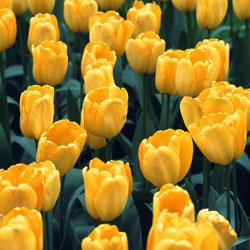 Members of the lily family, tulips are native to central and western Asia. In the 16th century, they were introduced to the Netherlands where most tulip bulbs are grown today. With over 100 species and nearly 3,000 varieties, tulips have been divided into 14 groups, including Darwin hybrids, Triumph, Lily-flowering, Double early, Rembrandt, Scheepers’ Hybrids (or French) and Parrot variations. Their classification is based on form and habit. A 15th group includes species tulips with the smallest plants growing to just 3 inches.
Members of the lily family, tulips are native to central and western Asia. In the 16th century, they were introduced to the Netherlands where most tulip bulbs are grown today. With over 100 species and nearly 3,000 varieties, tulips have been divided into 14 groups, including Darwin hybrids, Triumph, Lily-flowering, Double early, Rembrandt, Scheepers’ Hybrids (or French) and Parrot variations. Their classification is based on form and habit. A 15th group includes species tulips with the smallest plants growing to just 3 inches.
Tips for Planting Tulips
Tulips are an easy care addition to any landscape, and they are easier to plant than many gardeners realize.
- Choose only top-sized bulbs without any bruises or obvious damage. Bigger bulbs generally indicate better quality and bigger flowers.
- Plant bulbs as soon as purchased or store in a cool, dry location.
- Choose a sunny (or part sun) location with well-drained, rich soil.
- Plant 2” deeper than recommended to promote re-blooming each year.
- Apply bone meal 3 times a year – in fall when you plant, in spring as bulbs emerge from the ground and after flowering has finished. This will provide food for the foliage and bulb growth for next year’s flowers.
- Protect tulip bulbs from pest damage by laying wire mesh on top of your bed just beneath the soil. Sprinkling VoleBlok in the holes when planting can also be helpful.
- Mulch and water the bed thoroughly after planting.
- Plant before the ground freezes.
- Deadhead flowers after they have faded, but leave the foliage to die back naturally. Do not cut off the leaves until they have turned brown, or else they will not develop large enough bulbs for a good show the next year.
Tulip Timesaving Tip
Don’t have much time to plant a large, luxurious tulip bed? Plant 100 tulips in just 1 hour!
- Choose a part to full sun location and dig a hole 6’ x 6’ to a depth of 6-8”, placing the displaced soil on plywood or cardboard.
- Place 100 tulips, pointed end up, evenly over the area.
- Gently slide the soil from the plywood or cardboard onto the tulip bulbs. Tamp the soil lightly, sprinkle the bed with bone meal and water well. In spring, the entire area will bloom!
Tried & True Tulip Selections
Some tulips can be finicky, and while some tulips will disappear from your garden after a year or two, these selections promise trouble-free blooms for years!
- ‘Daydream’ – Darwin tulip, changing colors while in bloom to vibrant apricot-orange, blooms mid-April into May, Ht: 22”. Fragrant.
- ‘Lilac Wonder’ – Species tulip, large rose-lilac flowers with yellow bases and anthers, blooms May, Ht: 7”. Prefers full sun.
- T. praestans ‘Fusilier’ – Multi-flowering species tulip, orange-scarlet flowers, blooms April, Ht: 8-12”.
- T. clusiana var. chrysantha – Species tulip, good naturalizing tetraploid, deep yellow flushed with rose toward the edges, blooms April, Ht: 8”.
- ‘Pink Impression’ – Darwin tulip, huge flower with strong, clear pink flowers, blooms mid-April to May, Ht: 22”.
- ‘Menton’ – Scheepers’ hybrid, blooms are shades of apricot, rose, pink and peach, late-blooming, Ht: 26”.
- ‘Mrs. John T. Scheepers’ – Huge Scheepers’ hybrid, golden-yellow tetraploid is a three-time award winner, late-blooming, Ht: 26”.
- ‘Persian Pearl’ – Species tulip, deep magenta-rose with buttercup yellow star on the inside, blooms April, Ht: 6”.
- ‘Maureen’ – Scheepers’ offspring, large, oval-shaped flowers of glistening white, blooms late-May, Ht: 28”. Four-time award winner!
- ‘La Courtine’ – A Scheepers hybrid, yellow flowers are oval-shaped, flamed with red from the bottom up, late-blooming, Ht: 26”.
With so many to choose from, it’s always time for tulips!




